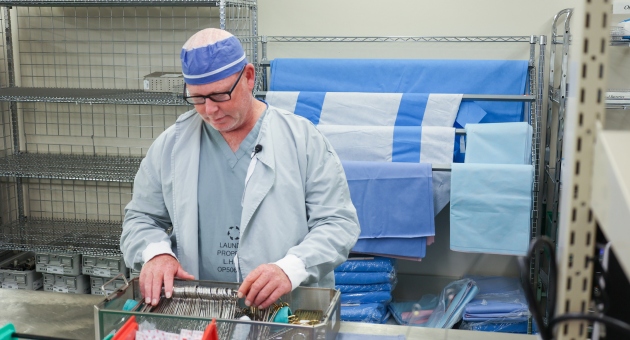
Tim Hammond works to keep patients safe as a Medical Device Reprocessing technician at London Health Sciences Centre.
April 17, 2025
The night shift in the Medical Device Reprocessing (MDR) department at London Health Sciences Centre (LHSC) is characterized by the clang of metallic instruments and the hum of machines. Tim Hammond, a MDR technician, has been at LHSC for over 23 years and currently works the night shift at University Hospital. He helps ensure the medical devices used in procedures and surgeries are decontaminated, assembled and sterilized.
“We're a crucial step when people get surgeries," says Hammond. “To me, on night shift, we're kind of the ambassadors to open-up the hospital for the next day.”
Hammond joined LHSC shortly after moving to London and feels like he was in the right place at the right time.
What does a MDR technician do?
MDR technicians are credentialed professionals who ensure the highest level of patient safety by cleaning, disinfecting, sterilizing, and maintaining medical equipment. They inspect and test devices, track inventory, and ensure compliance with safety standards and regulatory guidelines. Spread across the hospital, they are located at University Hospital, Victoria Hospital, Children’s Hospital, and the Nazem Kadri Surgical Centre. They provide crucial support to planned and emergency surgeries and procedures. The teams at University and Victoria Hospital operate 24 hours a day, seven days a week, 365 days a year ensuring the availability and functionality of medical instruments for patient care.
“In my role as an overnight MDR technician, I come in at 7:00 at night, and pick the instruments for cases the following day,” explains Hammond. During the night, he and his colleagues process the medical devices that were used during the day, or earlier that night, during urgent cases like transplants and emergency operations. They also prepare the medical devices that will be needed for the next day.

What do you like best about your role?
“I like coming into work every night because I'm not just at one station, like they are on days,” says Hammond. “When there's only five of us as opposed to possibly 15 during the day, we have to work at all the stations as opposed to just one, as we frequently need to step in and know what needs to get done to ensure the medical devices are ready for the next day.”
The night shift is a small team working together. “We know each other's next move and when one of us is done, we’ll go help somebody else,” says Hammond. “It's definitely a team effort.”
What does patient safety mean to you?
Hammond explains that MDR have various double checks in place that help increase patient safety including the system for packaging medical devices for an upcoming surgery or procedure, or how the computer requires an extra click making sure the team member has checked the equipment.
“For me, patient safety is a very important aspect of my work,” says Hammond. “The whole team here in MDR takes patient safety seriously.”
Patient Safety at LHSC video:
